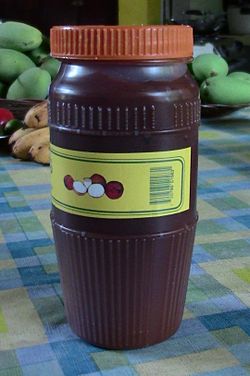Coconut jam
This article needs additional citations for verification. (July 2017) |
 A jar of coconut jam sold in the Philippines | |
| Alternative names | matamís sa báo, matamís na báo, sangkhaya, sekaya, seri kaya, srikaya, kaya |
|---|---|
| Type | Spread |
| Place of origin | Possibly Portugal[1] |
| Region or state | Maritime Southeast Asia |
| Associated cuisine | Singapore, Malaysia, Indonesia, Brunei, Philippines, and Thailand |
| Main ingredients | Coconut, sugar, eggs |
Coconut jam (Filipino: matamís sa báo, matamís na báo; Indonesian: seri kaya, srikaya; Malaysian: kaya, Vietnamese: ca dé) is a jam made from a base of coconut milk, eggs and sugar. It is popular in Southeast Asia, mainly in Brunei, Indonesia (especially in Palembang), Malaysia, the Philippines, Singapore and Thailand.
History
The origin of Kaya Jam is unclear, but it is believed to have been brought over from Portugal during the occupation of Melaka in the 15th century. The cuisine is claimed to have been invented by Portuguese descendants of Melaka. The current coconut jam served in southeast Asia, is highly similar to the Portuguese traditional cuisine, Doce De Ovos (Sweet egg cream).[1]
Indonesia, Malaysia and Singapore

The word for coconut jam in the Malay language, kaya, means rich, referencing the texture of the popular food. For Malaysians, Indonesians and Singaporeans, kaya,[2] also called srikaya (coconut egg jam), is a sweet creamy coconut spread made from coconut milk (locally known as santan) and duck or chicken eggs (which are flavored with pandan leaf and sweetened with sugar). The resulting color varies depending on the color of the egg yolks, the amount of pandan, and the extent of the caramelization of the sugar. As a popular local spread, kaya is typically spread on toast to make kaya toast and eaten in the morning,[3] but is also enjoyed throughout the day. Kaya can be found in most kopitiam and night markets.
Different varieties available include the nyonya kaya, which is of a lighter-green color, and Hainanese kaya, which is of a darker brown and uses caramelized sugar, and is often further sweetened with honey.
In Singapore, Malaysia and Indonesia, kaya is also used as a topping for several desserts including pulut taitai or pulut tekan, a dessert of sweet glutinous rice colored blue with butterfly pea flowers (bunga telang), and pulut seri muka, a similar dessert but colored green due to adding pandan leaves. It is also used with glutinous rice to make kuih seri kaya.
Philippines
Philippine coconut jam is known as matamís sa báo (also matamís na báo or minatamís na báo, among other names). The names literally mean "sweetened coconut". It is different from other Southeast Asian versions in that it uses coconut cream (kakang gata, the first and second press of grated coconut meat) and cane sugar extract or molasses (treacle). It also does not use eggs and thus is more like syrup rather than custard. It is often eaten on toast or pandesal or used as a filling for pan de coco. When it is mixed with ground glutinous rice paste, it becomes a popular dessert known as kalamay.[4]
A less viscous version made with coconut milk (gata) is known as latik (anglicized as "coconut caramel"), and is used in place of syrup in numerous native Filipino desserts.[5][6]
Thailand
The kaya of Thailand is called sangkhaya (Thai: สังขยา, pronounced [sǎŋkʰàjǎː]) in Thai. There are two major types of kaya eaten in Thailand. One type is more liquid than the other, while the less thick kaya is similar to what is eaten in Malaysia and Indonesia. People either spread it on steamed or toasted bread or dip the bread into kaya. This kind of kaya is commonly sold by street vendors but has recently been brought into tea and coffee shops.
Another type is a concoction that has a less sticky and more custard-like texture. It is sometimes called "coconut custard" in English and is used to make sangkhaya fakthong (สังขยาฟักทอง, [sǎŋkʰàjǎː fáktʰɔ̄ːŋ]; sangkhaya maryu in Lao), sangkhaya pumpkin or custard pumpkin, khao niao sangkhaya (ข้าวเหนียวสังขยา, [kʰâːw nǐaw sǎŋkʰàjǎː]), glutinous rice with sangkhaya, and sangkhaya maphrao (สังขยามะพร้าว, [sǎŋkʰàjǎː māpʰráːw]), sangkhaya served in a coconut.
See also
References
- ^ a b Geraldo Affonso Muzzi (3 January 2014). The Portuguese in Malay Land. Edições Vercial; 2 edition. p. 64. ASIN B0043RSCVA.
- ^ Julie Wong (3 August 2014). "Kaya: A rich spread". The Star. Retrieved 16 April 2015.
- ^ Michael Aquino. "Roti Kaya – a Favorite Kopitiam Breakfast throughout Malaysia and Singapore". About Travel. Retrieved 16 April 2015.
- ^ "Minatamis na Bao (Coconut Jam)". Kawaling Pinoy. Retrieved 18 December 2018.
- ^ "Bisaya translation for "latik"". Bisaya Translator and Cebuano Dictionary. Archived from the original on 11 August 2013. Retrieved 5 July 2011.
- ^ "Philippine quarterly of culture and society". 32. University of San Carlos. 2004: 31.
{{cite journal}}: Cite journal requires|journal=(help)
External links
- Famous Thai Dishes including photos of Thai sangkhaya desserts
- Not your usual kaya with three recipes made with palm sugar, pumpkin and taro


